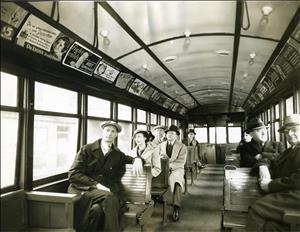On August 11, 1940, dozens of young men demolish the Queen Anne Counterbalance streetcar as it makes its final run through Seattle's Queen Anne neighborhood. What starts out as a jolly prank leaves a streetcar scourged, its operators rattled, and 20 youths charged with malicious destruction of property. The Seattle Daily Times editorializes against what it calls mob violence, but the affair soon blows over. One of those arrested later becomes a successful attorney, and in 2020 the firm he co-founded is still practicing law in the Norton Building in Seattle.
Rowdy Riders
The Queen Anne Counterbalance streetcar began operation in 1901 and served the Queen Anne neighborhood until 1940, when the City of Seattle began phasing out its streetcars and replacing them with trackless trolleys and buses. The Counterbalance's final run was scheduled for 1 a.m. on Sunday morning, August 11. There had been episodes of rowdy riders trashing streetcars on their final runs, both in Seattle and in other cities, but this hadn't caused much concern as the streetcars were headed for the scrap heap anyway. Nevertheless, Seattle police kept an eye on some of the final streetcar runs throughout the city that summer, but didn't anticipate any issues with the Counterbalance's final run.
The trolley started its trip with perhaps 40 passengers taking a sentimental last ride, but the nostalgia didn't last long. As the car began the long climb northbound up Queen Anne Avenue from Mercer Street, the streetcar operator, W. W. Wiley (1880-1953), saw that the rails had been greased in an effort to stop the car, but he had sand on hand and put it on the rails for traction. He proceeded to the dogleg in the road at the top of the hill, at the intersection of Queen Anne Avenue and Galer Street, where a cheering crowd waited. In front of them, a line of garbage cans perhaps 30 feet long blocked the tracks. Wiley stopped and opened the door.
Several dozen young men stormed the trolley, overwhelming the five transit employees onboard, and cut the rope connecting it to the wire above. Wiley reattached the rope, but the men cut it again. It was just the beginning. A crowd estimated at between 40 and 70 youths, some following the streetcar in automobiles, attacked it over the next hour as it traveled through East Queen Anne, stripping it of its seats, straps, light bulbs, and everything that wasn't bolted down. They pelted the streetcar and its passengers with rotten tomatoes, corncobs, and fruit. According to the Seattle Post-Intelligencer, these riders scattered, "leaving [the trolley] like a thing accursed after the self-appointed wrecking crew had begun pulling it to pieces around them" ("Mob Wrecks ...").
The battered streetcar finally made it to the trolley barn at 5th Avenue N and Mercer Street about 2:30 a.m., having taken an hour and a half to travel three miles. "There was nothing left of it except two trucks, some control levers and a battered framework" ("20 Face ..."), recounted the Seattle Daily Times. Every glass pane in the car was broken, about two-thirds of its seats had been ripped out, even its gongs were gone. A mob of revelers spilled off the car, but their exuberance waned when the police arrived and Wiley demanded the arrest of two of them, Wallace Aiken and Robert Waiste. More arrests followed over the next few days; eventually 20 were charged with malicious destruction of property.
Mob Scene
The Seattle Star covered the episode in a short article, while the Post-Intelligencer was more thorough. But it was the Seattle Daily Times that covered the melee in vivid detail, quoting Aiken from a statement he gave to the police and including a picture of him and Waiste in its coverage. The Times also interviewed Inspector Wiley, reporting that he "described the storming of the trolley as 'something like a cross between an earthquake and a cyclone'" ("20 Face ..."). He declared:
"The cyclone struck when we reached the top of the counterbalance hill. My ears still are ringing from the din. About 70 youths stormed the car. They came through windows and doors. They swarmed over the top of the car. They shouted, laughed and stomped their feet. Then they cut the trolley rope" ("20 Face ...").
Wiley added that the "earthquake" struck when the pranksters "began to get playful. They rocked the car. They smashed windows. Next they ripped up the seats. It sounded like the crashing of trees in a logging camp. They tossed the seats around, then heaved them through the remaining unbroken windows" ("20 Face ...").
The Times featured a stern front-page editorial in its August 12 edition, titled "MOB VIOLENCE!", decrying the "spirit of mob violence" and prophesizing that it "might lead to other and more serious mob action ... Light-hearted youthful jubilation over the passing of Seattle's street cars is no excuse for organized violence!" But the storm passed. Trial was scheduled for September 16, 1940, for nine of the defendants, but at the 11th hour, Wiley relented and asked the court to dismiss all charges.
One of the defendants, Wallace Aiken (1919-2000), was a law student at the University of Washington, a fact noted by both the Post-Intelligencer and the Times. His obituary 60 years later mentioned the trolley trashing and said that he had the head of the law school bail him out of jail. Aiken went on to become a well-known and respected attorney, remembered for his humor and for his support of those less fortunate. In 1959, he and another partner started a law firm in Seattle that continues in 2020 as Aiken, St. Louis & Siljeg.

